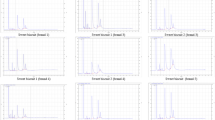Abstract
The fat contents of 12 brands of biscuits were extracted and evaluated for free fatty acids (FFA) and their fatty acid composition (FAC). The oil content and FFA varied from 13.7 to 27.6% and 0.2 to 1.0%, respectively. The FAC was analyzed by gas chromatography–mass spectroscopy with particular emphasis on trans fatty acids (TFA). Total saturated, unsaturated, cis-monounsaturated and polyunsaturated fatty acids were determined in the range of 37.9–46.9, 53.0–62.0, 12.3–43.7 and 0.1–9.2%, respectively. The high amount of TFA was observed in all biscuit samples and varied from 9.3 to 34.9%. The quantity and quality of the lipid fraction of the biscuits indicated that the all analyzed biscuits are a rich source of fat, saturated fatty acids and trans fatty acids, consequently not suitable for the health of consumers. The high content of trans fatty acids and palmitic acid also indicated that blends of RBD palm oil and partially hydrogenated oil had been used in the biscuit manufacturing.
Similar content being viewed by others
References
Maache-Rezzoug ZB, Jean-Marie KA, Christian P (1998) Study of mixing in connection with the rheological properties of biscuit dough and dimensional characteristics of biscuits. J Food Eng 35:43–56
O’Brien CM, Chapmen D, Neville DP, Keogh MK, Arendt EK (2003) Effect of varying the microencapsulation process on the functionality of hydrogenated vegetable fat in short dough biscuits. Food Res Int 36:215–221
Jissy J, Leelavathi K (2007) Effect of fat-type on cookie dough and cookie quality. J Food Eng 79:299–305
Sudha ML, Srivastava AK, Vetrimani R, Leelavathi K (2007) Fat replacement in soft dough biscuits: Its implications on dough rheology and biscuit quality. J Food Eng 80:922–930
Willett WC (2006) Trans fatty acids and cardiovascular disease-epidemiological data. Atheroscler Suppl 7:5–8
Bhanger MI, Anwar F (2004) Fatty acid (FA) composition and contents of trans unsaturated FA in hydrogenated vegetable oils and blended fats from Pakistan. J Am Oil Chem Soc 81:129–134
Kandhro A, Sherazi STH, Mahesar SA, Bhanger MI, Talpur MY, Rauf A (2008) GC–MS quantification of fatty acid profile including trans FA in the locally manufactured margarines of Pakistan. Food Chem 109:207–211
International Association for Cereal Chemistry (1982) Standard methods of the international association for cereal chemistry standard no: 136 ICC. Detmold, Germany
American Oil Chemists’ Society (1997) Official methods and recommended practices of the American Oil Chemists’ Society, 4th edn. AOCS Press, Champaign
International Union of Pure and Applied Chemistry (1979) Standards methods for the analysis of oils, fats and derivatives, 6th edn. Pergamon Press, Oxford, pp 96–98
Daglioglu O, Murat T, Tuncel B (2000) Determination of fatty acid composition and total trans fatty acids of Turkish biscuits by capillary gas-liquid chromatography. Eur Food Res Technol 211:41–44
Manley D (1991) Technology of biscuits crackers and cookies. Ellis Horwood, Chichester
Caponio F, Summo C, Delcuratolo D, Pasqualone A (2006) Quality of the lipid fraction of Italian biscuits. J Sci Food Agric 86:356–361
Hu FB, Stampfer MJ, Manson JE, Ascherio A, Colditz GA, Speizer FE, Hennekens CH, Willet WC (1999) Dietary saturated fats and their food sources in relation to the risk of coronary heart disease in women. J Am Oil Chem Soc 70:1001–1008
Aro A, Jauhiainen M, Partanen R, Salminen I, Mutanen M (1997) Stearic acid, trans fatty acids, and dairy fat effects on serum and lipoprotein lipids, apolipoproteins, lipoprotein (a) and lipid transfer proteins in healthy subjects. J Am Oil Chem Soc 65:1419–1426
Perez-serradilla JA, Ortiz MC, Sarabia L, Luque de Castro MD (2007) Focused microwave-assisted soxhlet extraction of acorn oil for determination of the fatty acid profile by GC–MS. Comparison with conventional and standard methods. Anal Bioanal Chem 388:451–462
Mensink RP, Katan MB (1990) Effects of dietary trans fatty acids on high-density and low-density lipoprotein cholesterol levels in healthy subjects. N Eng J Med 323:439–445
Huang ZE, Wang B, Pace RD, Oh JH (2006) Trans fatty acid content of selected foods in an African–American community. J Food Sci 71:322–327
Hui QW, Huang XL, Lin XS, Huang F, Zhu ZX, Ye-Fen M (2007) Gas chromatographic retention time rule and mass spectrometric fragmentation rule of fatty acids and its application in food. Chin J Anal Chem 35:998–1003
Martin CA, Carapelli R, Visantainer JV, Matsushita M, de Souza NE (2005) Trans fatty acid content of Brazilian biscuits. Food Chem 93:445–448
Mcdonald RE, Mossoba MM (2002) Methods for trans fatty acid analysis. In: Akoh CC, Min DB (eds) Food lipids, 2nd edn edn. Marcel Dekker, Inc, New York, pp 169–203
HMSO, UK (1994) Department of Health. Nutritional aspects of cardiovascular disease. London, Report on Health and Social Subjects, vol 46, pp 37–46
Alonso L, Fraga MJ, Juarez M (2000) Determination of trans fatty acids and fatty acid profile in margarines marketed in Spain. J Am Oil Chem Soc 77:131–136
Acknowledgments
The National Center of Excellence in Analytical Chemistry, University of Sindh, Jamshoro, Pakistan is gratefully acknowledged for the financial support. The authors would also like to thank Iftikhar Ahmed consultant of Habib Oil Mills (Pvt) Ltd, Pakistan for his help and valuable suggestions.
Author information
Authors and Affiliations
Corresponding author
About this article
Cite this article
Kandhro, A., Sherazi, S.T.H., Mahesar, S.A. et al. Monitoring of Fat Content, Free Fatty Acid and Fatty Acid Profile Including trans Fat in Pakistani Biscuits. J Am Oil Chem Soc 85, 1057–1061 (2008). https://doi.org/10.1007/s11746-008-1297-8
Received:
Revised:
Accepted:
Published:
Issue Date:
DOI: https://doi.org/10.1007/s11746-008-1297-8




